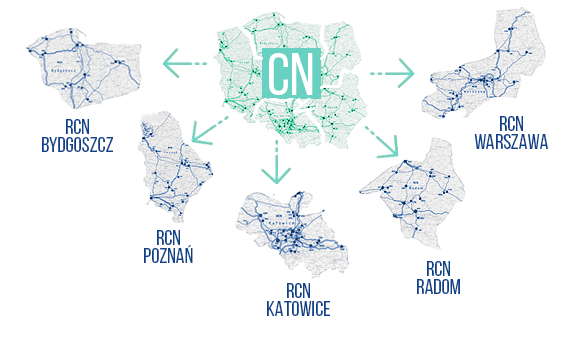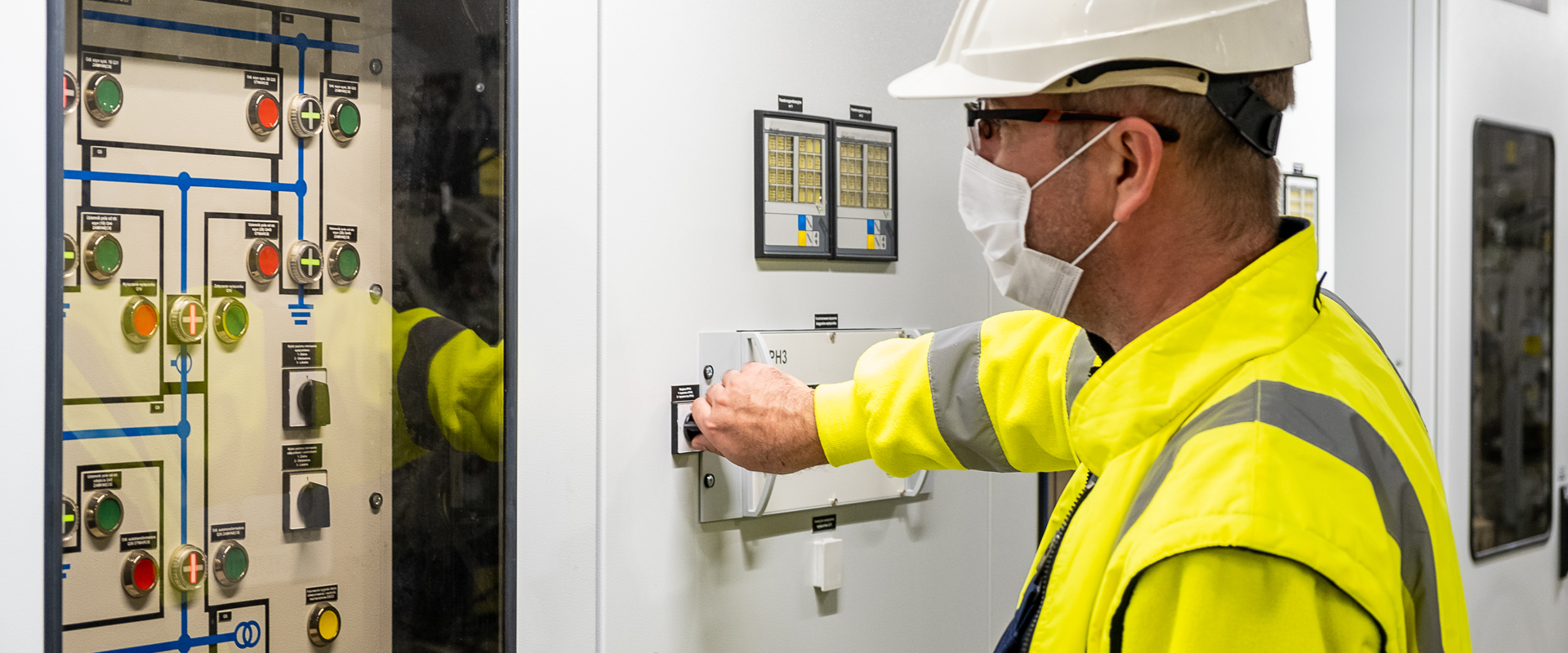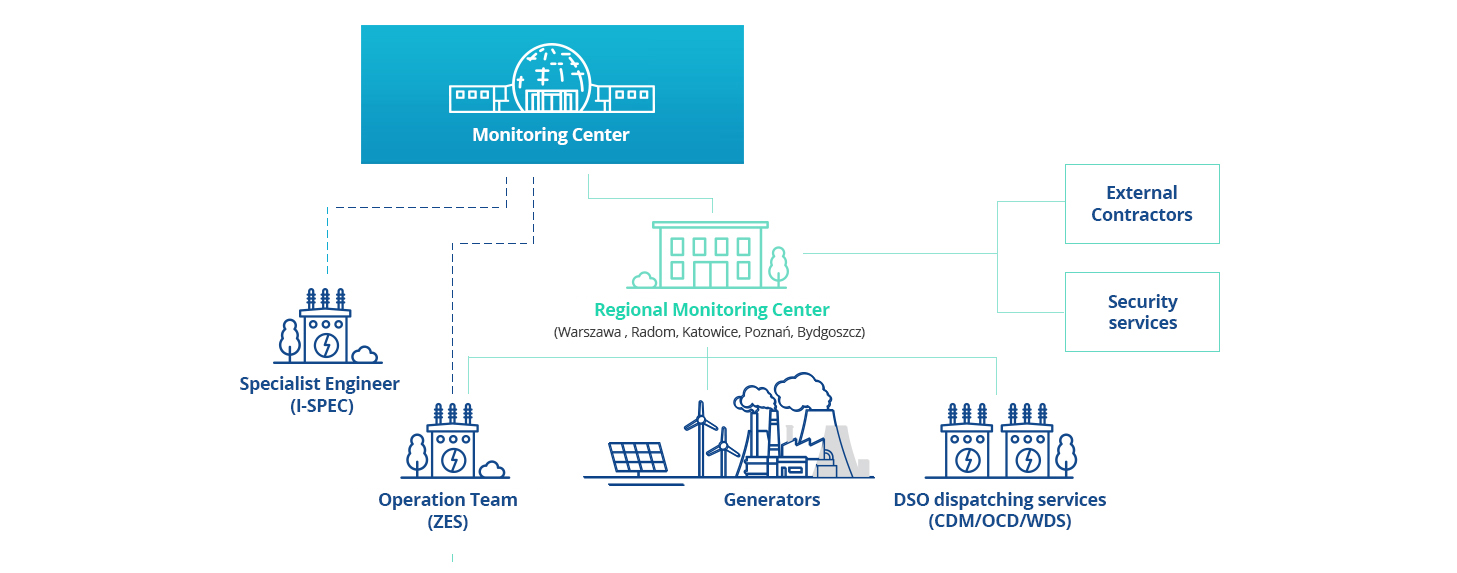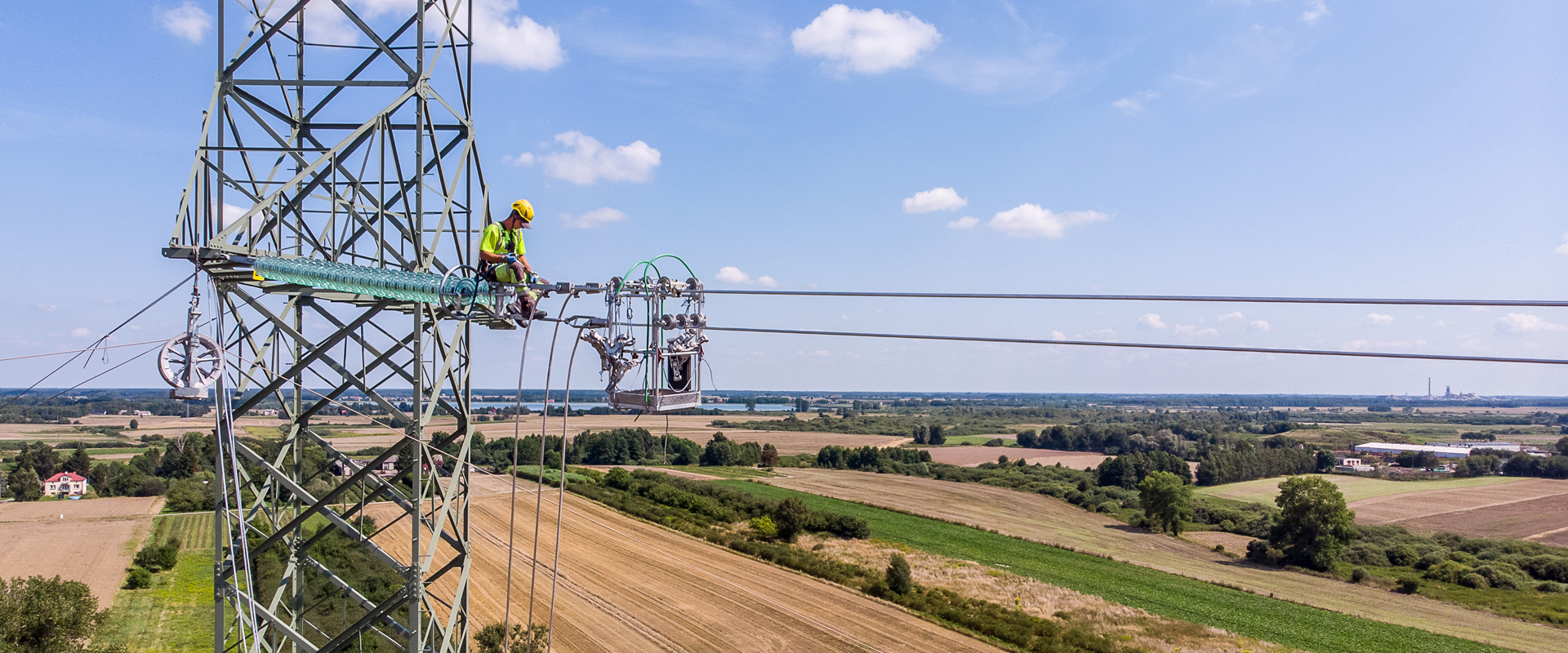Economic and market impact
The transmission network owned by PSE consists of 15,318 km of extra-high voltage lines and 109 substations. We maintain the technical condition and operating system of the network to meet applicable requirements. We are fully aware that the level of availability of our network facilities largely determines the operational safety of the entire system.
Our network infrastructure also includes a 450 kV submarine cable line with a length of 127 km. The length of the entire line connecting Poland with Sweden is 254 km.
Tab. 1. Overhead lines (above ground)
| GRI EU04 Length and number of overhead power lines | |||||
|---|---|---|---|---|---|
| 2020 | 2019 | ||||
| Voltage | Length (in km) given on a per-circuit basis | Number | Voltage | Length (in km) given on a per-circuit basis | Number |
| 750 kV | 114 km | 1 | 750 kV | 114 km | 1 |
| 400 kV | 7 824 km | 111 | 400 kV | 7 135 km | 104 |
| 220 kV | 7 380 km | 169 | 220 kV | 7 573 km | 175 |
| 110 kV | 75 km | 33 | 110 kV | 72 km* | 32 |
*A correction has been made to the data for this index published in the 2019 Impact Report.
Tab. 2. Length and number of cable power lines
| GRI EU04 Length and number of cable power lines | |||||
|---|---|---|---|---|---|
| 2020 | 2019 | ||||
| Voltage | Length (in km) given on a per-circuit basis | Number | Voltage | Length (in km) given on a per-circuit basis | Number |
| 450 kV DC | 450 kV DC Poland-Sweden submarine connection with a total length of 254 km (of which 127 km belong to PSE) | 1 | 450 kV DC | 450 kV DC Poland-Sweden submarine connection with a total length of 254 km (of which 127 km belong to PSE) | 1 |
Tab. 3. Number and power rating of transformers
| Number and power rating of transformers | |||||
|---|---|---|---|---|---|
| Transmission ratio in kV/kV | Transformers in 2020 | Transformers in 2019 | |||
| Number (pcs.) | Power rating (MVA) | Number (pcs.) | Power rating (MVA) | ||
| 50/400 | installed | 2 | 2 502 | 2 | 2 502 |
| reserve | - | - | - | - | |
| 400/220 | installed | 32 | 17 790 | 32 | 17 290 |
| reserve | - | - | - | - | |
| 400/110 | installed | 58 | 18 918 | 53 | 17 108 |
| reserve | 3 | 736 | 4 | 986 | |
| 220/110 | installed | 123 | 201 390 | 121 | 20 610 |
| reserve | - | - | 2 | 320 | |
| In total | installed | 215 | 240 600 | 208 | 57 510 |
| reserve | 3 | 736 | 6 | 1 306 | |
The condition of the transmission network is confirmed by the high combined availability index for transmission facilities (
DYSU
), which reached 99.73 percent in 2020 with reference value of 99.5.
Tab. 4. Availability index for transmission facilities - DYSU (in percent)
|
In-house indicator
Availability index for transmission facilities - DYSU (in percent) |
I-XII 2020 [%] |
I-XII 2019 [%] |
I-XII 2018 [%] |
I-XII 2017 [%] |
I-XII 2016 [%] |
Reference value of the DYSU index (internal document) [%] |
|---|---|---|---|---|---|---|
| Availability index for L1 category transmission lines [DL1] | 99,51 | 99,93 | 99,97 | 99,77 | 99,64 | |
| Availability index for L2 category transmission lines [DL2] | 99,73 | 99,89 | 99,92 | 99,58 | 99,63 | |
| Availability index for generator output lines [DLB] | 100,00 | 100,00 | 100,00 | 99,99 | 99,99 | |
| Availability index for transformers in S11 category substations [DS11] | 99,79 | 99,31 | 99,85 | 99,85 | 99,85 | |
| Availability index for transformers in S22 category substations [DS22] | 99,62 | 99,74 | 99,76 | 99,67 | 99,59 | |
| DYSU | 99,73 | 99,77 | 99,90 | 99,77 | 99,74 | ≥ 97,5 |
Monitoring of the transmission network
GRI 103-2
Maintaining network assets requires performing ongoing monitoring of the operation and condition of the various components in the transmission network. This task is carried out by the operation monitoring service: Monitoring Center (CN) in Konstancin-Jeziorna and five Regional Monitoring Centers (RCN) in the locations of the organizational units in: Warsaw, Radom, Katowice, Poznań and Bydgoszcz. The monitoring services operate on the basis of a hierarchical model where the Regional Monitoring Centers functionally report to the Monitoring Center and are responsible for a designated area of PSE's network assets.

The primary role of operation monitoring services is:
- ongoing monitoring (24/7) over the operation and technical condition of the network assets owned by PSE,
- provision of continuous control and preview of facilities, equipment and systems,
- ensuring the availability and safety of equipment operation,
- supervision of work in progress,
- execution of switching and control operations in accordance with the adopted operational division of competence between KDM/ODM dispatching services and CN/RCN operation monitoring services,
- coordination by Regional Monitoring Centers of work orders at substations and lines in accordance with the provisions of the Occupational Health and Safety Manual for power equipment and systems,
- planning and optimization of maintenance and investment works carried out on PSE's network assets,
- cooperation with DSO units, generators and contractors.

CN/RCN operation monitoring services play a key role in the event of disturbances or failures on the transmission network assets, during which, based on e.g. signaling in SCADA systems or notifications from other entities, actions are initiated and disturbance elimination processes are activated. They continuously monitor the condition of the transmission network facilities, defining temporary or quantitative limitations in their operation, affecting the operational conditions.
Actions taken by CN/RCN services in an emergency situation include:
- an analysis of the causes, location, and magnitude of the disturbance,
- organization of securing the event location,
- deciding how the disturbance will be resolved,
- having available resources of Operations Teams (ZES) and Specialist Engineers (I-SPEC) to organize the elimination of the disturbance,
- monitoring and coordinating work related to the elimination of the disturbance.
In the event of a widespread inter-area failure (between the areas of responsibility of the territorially competent RCNs), individual RCNs cooperate with each other. In this case, the Monitoring Center coordinates all activities of PSE's operating services (from different areas) and subcontractors working on behalf of our organization.
In the process of maintaining network assets, CN/RCN's operations monitoring services are supported by Operations Teams (ZES) and Specialist Engineers (I-SPEC) with the knowledge and skills to act directly on the equipment. Nationwide, 28 Operation Teams have been established within the PSE structures. Employees of ZES through their work, ensure the safety of operations, diagnostic and maintenance activities. The competence and specialized skills of ZES employees are maintained at a high level through systematic process training courses. The launched Operational Services Development Program provides comprehensive and systematic training courses.
The pandemic conditions prevailing in the country for a long time did not significantly affect the operation of the operation monitoring services, except for a temporary reduction in the execution of scheduled works during the initial period of increase in the number of infections. Currently, CN/RCN service activities are dispersed - that is, in both primary and backup locations - and have returned to pre-pandemic intensity, of course, while maintaining current sanitary and epidemiological requirements. The work of the Operation Teams and I-SPEC has also returned to its previous intensity.
In the process of maintaining network assets, CN/RCN's operations monitoring services are supported by Operations Teams (ZES) and Specialist Engineers (I-SPEC) with the knowledge and skills to act directly on the equipment. Nationwide, 28 Operation Teams have been established within the PSE structures. Employees of ZES through their work, ensure the safety of operations, diagnostic and maintenance activities. The competence and specialized skills of ZES employees are maintained at a high level through systematic process training courses. The launched Operational Services Development Program provides comprehensive and systematic training courses.
The pandemic conditions prevailing in the country for a long time did not significantly affect the operation of the operation monitoring services, except for a temporary reduction in the execution of scheduled works during the initial period of increase in the number of infections. Currently, CN/RCN service activities are dispersed - that is, in both primary and backup locations - and have returned to pre-pandemic intensity, of course, while maintaining current sanitary and epidemiological requirements. The work of the Operation Teams and I-SPEC has also returned to its previous intensity.

GRI 103-1
Out of 109 substations owned by PSE, as many as 83 are remotely controlled and monitored, which allows switching operations to be performed from KDM/ODM/CN/RCN master centers and thus streamlines the operation of the NPS. Successively, through retrofits, other substations are being adapted to the standard of remotely controlled and monitored substations. For substations where the remote control and monitoring function is limited from master centers, all operating activities are performed by the operating staff of the substation or ZES.
All the aforementioned activities of the operating services allow for maintaining the transmission network in the proper condition that enables its full transmission capacity to be maintained, which consequently enables the dispatching services to fulfill their duties related to conducting network operation.
All the aforementioned activities of the operating services allow for maintaining the transmission network in the proper condition that enables its full transmission capacity to be maintained, which consequently enables the dispatching services to fulfill their duties related to conducting network operation.
Cases of threats to the operation of EHV transmission lines caused by garden fabric
There are many external and environmental factors that pose a real threat to the operation of EHV transmission lines. In recent years, various types of garden fabrics used in agriculture have become a significant problem. As a result of improper attachment to the ground and under the influence of wind gusts garden fabric floats in the air and encounters an obstacle in the form of power line elements and effectively wraps itself on the pole structures, insulators, live or lightning conductors.
Many times parts of floating garden fabrics are so long that they catch on the live wires of all phases, while touching the ground. This poses an obvious danger to the operation of the transmission line, but also to bystanders, threatening them with electric shock by the electric current of very high voltage. Identification of such a threat is always associated with securing the incident site by appropriate services and emergency shutdown of lines - often including lines that cannot be shut down from the point of view of system operation - in order to eliminate the threat. Removal of the garden fabric takes at least several hours, among other things because of the need to prepare a safe work zone and the use of lifts, and often because of the complicated entanglement of the garden fabric in the line elements.
Each unscheduled shutdown of a line for such work generates high costs and the involvement of personnel, including the Operation Teams, who must interrupt their scheduled work. The number of such cases found is increasing every year. While there were 9 in 2019, there were already 13 in 2020.
Many times parts of floating garden fabrics are so long that they catch on the live wires of all phases, while touching the ground. This poses an obvious danger to the operation of the transmission line, but also to bystanders, threatening them with electric shock by the electric current of very high voltage. Identification of such a threat is always associated with securing the incident site by appropriate services and emergency shutdown of lines - often including lines that cannot be shut down from the point of view of system operation - in order to eliminate the threat. Removal of the garden fabric takes at least several hours, among other things because of the need to prepare a safe work zone and the use of lifts, and often because of the complicated entanglement of the garden fabric in the line elements.
Each unscheduled shutdown of a line for such work generates high costs and the involvement of personnel, including the Operation Teams, who must interrupt their scheduled work. The number of such cases found is increasing every year. While there were 9 in 2019, there were already 13 in 2020.
| No. | Route of EHV line | Span or stand number | Nearest town/village | Commune/City/Town |
|---|---|---|---|---|
| 1 | L220 kV Miłosna-Mory | 52 | Warszawa | Warszawa |
| 2 | L220 kV Kozienice-Mory, Kozienice-Piaseczno | 147 | Miedzechów | Jasieniec |
| 3 | L220 kV Mory-Podolszyce | 308-309 | Sanniki | Sanniki |
| 4 | L400 kV Płock-Rogowiec | 313-314 | Kompina | Nieborów |
| 5 | L220 kV Ołtarzew-Sochaczew | 388 | Stary Łuszczewek | Błonie |
| 6 | L220 kV Mory-Podolszyce | 275-276 | Koszelew | Gąbin |
| 7 | L220 kV Mory-Podolszyce | 295-296 | Lwówek | Sanniki |
| 8 | L220 kV Klikowa-Skawina, Klikowa-Lubocza | 94-95 | Złotniki | Igołomia-Wawrzeńczyce |
| 9 | L220 kV Lubocza-Siersza t. 1 | 126 | Prusy | Kocmyrzów-Luborzyca |
| 10 | L400 kV Ołtarzew-Rogowiec | 308-309 | Zabostów Duży | Łowicz |
| 11 | L400 kV Ołtarzew-Rogowiec, Płock-Rogowiec | 311 | Zabostów Duży | Łowicz |
| 12 | L220 kV Lubocza-Klikowa | 90-91 | Odwiśle | Igołomia-Wawrzeńczyce |
| 13 | L220 kV Lubocza-Klikowa | 101 | Grobla | Igołomia-Wawrzeńczyce |

PSE warehouse management
PSE's warehouse management of network assets is intended to provide an inventory of instruments, equipment, spare parts, components and items necessary for the performance of works related to the proper maintenance of the company's network assets. Warehouse management is also intended to allow for the accumulation of inventory for current tasks and maintenance of the organization's asset infrastructure.

Key figures
7
major warehouse
locations of PSE:
2 in Radom and Bydgoszcz and 1 in: Warsaw, Katowice and Poznań,
45
storage depots
all over the country.
-
-
-
The works within the process of stock management of network assets are coordinated by the Equipment and Materials Reserve Operator (hereinafter: Reserve Operator). The main task of this unit is to maintain the warehouse stocks at an appropriate level in accordance with the standard established by the PSE Operations Department, which specifies the minimum numbers of equipment of particular types that should be kept in the storage reserve to ensure the continuity of the company's operations, e.g. in an emergency situation. In addition, non-standard stocks are also accumulated in the warehouse.
Currently stored in the warehouse are:
- instrumentation for primary circuits, including: circuit breakers, measuring transformers, isolating switches, surge arresters, auxiliary transformers,
- instrumentation for secondary circuits, including: protection devices (distance, sectional, earth fault, differential protection), ARNE/ARST automatic control systems, relays, transmitters,
- HVDC components: dedicated equipment for the Słupsk DC substation,
- line components, including: EHV line support structures, glass and porcelain insulators, line fittings, conductors, cables,
- power transformer components, including, for example, bushing insulators and on-load tap changers.
The release of equipment and materials from the warehouse reserve together with the required means of transport and loading is handled by the Logistics Center which is on 24-hour standby. The works of the Logistics Center are carried out jointly by employees of the Reserves Operator (during warehouse working hours) and the RCN Radom (in the afternoon, at night, on weekends and public holidays). Rapid response and efficient transportation can significantly reduce the time for removal of major failures in the NPS.

Key figures
PLN 112,7
millions
Expenditures incurred for maintenance and repair tasks of network facilities in 2020.
